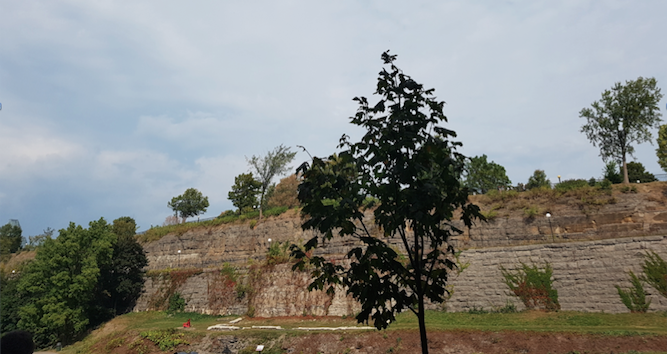Scarcity of green space robs Centretown of Canada 150 grove
By Aidan Chamandy
A lack of available green space in downtown Ottawa has made Somerset the only municipal ward in the city that isn’t planting a 150-tree maple grove to mark the country’s sesquicentennial.
As part of the celebrations for the 150th anniversary of Confederation, the city promised to plant a grove of 150 maple trees in each of Ottawa’s 23 municipal wards.
However, a scarcity of available green spaces large enough to accommodate that many trees in one location in the urban core scuttled the plan for Centretown’s legacy grove.
Instead the city invited residents to apply to take possession of one the ward’s 150 designated trees for planting on those residents’ private property.
Tracery Schwets, program manager for the city’s forest management branch, spoke to the challenge of finding substantial stretches of greenery in Centretown.
“In urban environments, there are many considerations to be made to find appropriate locations to plant trees,” she said. This includes factors such as “soil volume, the location of utilities both above and below ground, winter snow storage, and setbacks from pathways, roads, and sidewalks.”
Somerset Ward Coun. Catherine McKenney echoed Schwets’ comments.
“Disease, root damage from construction, and difficulty protecting trees,” she recently said, “means that all too often we lose fragments of our urban forest that takes decades to replace.”
Somerset Ward has the least green space of all 23 municipal wards. During her 2014 election campaign, McKenney pledged to work for more green space.
In 2015, she opposed a plan to establish community mailboxes on the grounds that it would further reduce Centretown’s already limited amount of green space.
Meg McCallum, director of membership and communications at the affordable housing provider Centretown Citizens Ottawa Corporation, said she’s concerned that the lack of green space disproportionately affects low−income Centretown residents.
“When you live in a dense urban environment, particularly for our tenants who live in pretty modest homes, having a public amenity that gives them extra living space makes the liveability of your neighbourhood much better.”
Tomas Whillans, president of the Centretown Citizens Community Association, said he is worried green space is not being prioritized.
“We often look from a budgetary or investment perspective at grey infrastructure (sidewalks, hydro poles, street lights). Ultimately, we need to consider the importance of green space in Ottawa,” he said. “If we don’t have our trees and green space, grey infrastructure will take over and it just won’t be the city we all love to live in.”
Whillans said he is especially concerned about how the O−Train expansion and Elgin Street development will affect the already sparse green space in Centretown.
Dan Brunton, a local ecologist, offered a different perspective on the Canada 150 Maple Groves project and urban green space in general.
Brunton said all too often our attempts to increase the city’s green space take the shape of merely planting trees.
“They do good things, but we simplify them out of existence. Environmental protection and habitat restoration can’t just be simplified into, ‘Let’s plant a bunch of trees.’”
This approach provides a limited ecological benefit when compared to other options, he said.
“When we plant all these trees, were doing it for our purposes. I don’t think we should be under any illusion that were creating natural habitats,” he said. “Planting 150 trees in each ward is a nice idea from a landscaping perspective, but I’d argue we don’t actually need more trees.”
If the intent of the project is purely aesthetic, Brunton has no qualms. However, he said a more fitting tribute to the 150th anniversary of Confederation would be to try to preserve already existing green spaces and then leave them totally undisturbed.
This would allow the organisms currently inhabiting that space to live without much human interference, creating an ecologically diverse area that is especially suited to the specific Centretown environment.
“If we protect the range of natural circumstances out there now, unknowingly we are protecting the future potential,” he said. “There are areas in Central Park (New York) that are really nice natural habitats. It was established in 1857, and has been paying benefits for tens of millions of people for the last 150 years.”

